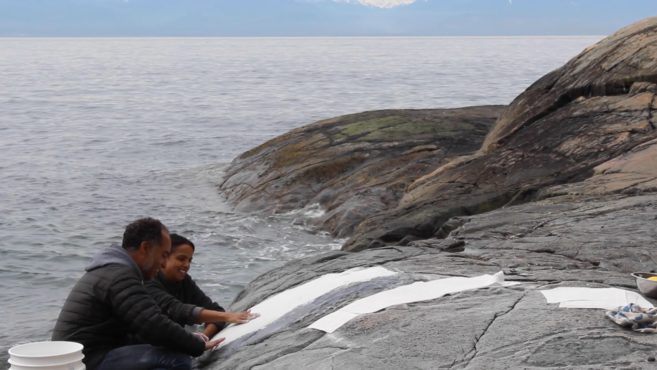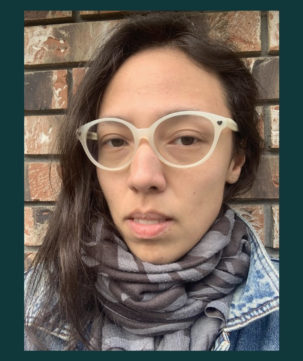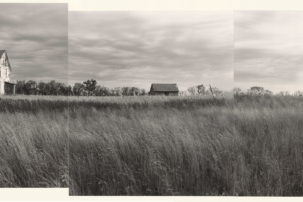Eli Hirtle: I’m wondering if you could talk a little bit about the process of locating yourself, and also your family and ancestors, and how that’s reflected in your films.
Sky Hopinka: The first film I did that was more experimental in nature was called Wawa (2014). It wasn’t about my family; it was about this language I learned, Chinuk Wawa, that wasn’t from any of my heritage languages or from my communities. I’d been living in Portland for a number of years at that point and wanted to learn a language, and ended up being involved with this language community. An important part of that film is how it represents or acknowledges six or seven generations of language speakers, teachers and students, and how those sorts of lineages can be collapsed into a thread. The majority of my films—even when they go back to look at my own family, with my dad or my grandmother, or at the landscapes we used to and continue to live on—are interested in finding ways to collapse history or the linear aspect of history. Rather than relegating things to the past, far past, distant past or whenever, it’s sometimes more productive for me to think about how histories exist together. And I suppose that for me they do exist together, within my grandma who passed away 10 years ago, or my dad, who passed away last year. I mean, they still feel very present, not only when I see these films or think about their representation, how their voices are still present, but also in making my work, in how I’m hoping to move forward in the future.
EH: Could you speak to the role of recordings and archives in your research, and how you’re thinking through your position as an artist as a way to approach and work with this material?
SH: There are so many reasons I feel archives are important; they’re sources of inspiration. It’s always nice to have material to work with that you don’t have to self-generate. For example, there might be a conversation that happened 40 years ago, and you can ask, How can I be part of this conversation? rather than thinking, I need to make everything on my own.
I used 25 hours of those kinds of recordings in a film called Anti-Objects, or Space Without Path or Boundary (2017). How can I look at what these two men, linguist Henry Zenk and Wilson Bobb, a 90-year-old Grand Ronde and Yakama Nation tribal member, were saying some 35 years ago, in 1982 or 1983? They’re talking about the language they speak, Chinuk Wawa, but they’re also talking about making eggs. They’re also visiting. I feel it’s really important to how I engage with, or even just think about, my own learning. It’s one thing to look at words on a piece of paper and try to memorize them. But it’s another to hear people using the language and hearing them play in the language and tease each other in the language. I’m more interested in that sort of activation and active engagement with archived materials, rather than the facts they offer. In my film Jáaji Approx. (2015) I’m essentially documenting my dad over the course of 10 years. Throughout, I introduced recordings with some dates and times. Some are made up and some are real. Even how those facts are presented—I think it’s a way to question how we’re taught to look at our histories. Do we need archives to understand who we were? According to some anthropologists, we do. According to some Elders and some people involved in the community, we don’t. It doesn’t have to exist as a boundary between the archives and the intergenerational knowledges passed down to us. There are ways to engage with both. And I’m trying to figure out how to engage with both because of a personal struggle that I have relating to certain things around my tribe and our history. Paul Radin wrote a book called The Winnebago Tribe in 1923, and in some ways, it’s a source of information that I don’t have access to otherwise. It’s like sharing cultural knowledge that shouldn’t be shared. And so what does that mean? I’ve only dabbled in looking at that book, but at this point, should I read it? Should I not? I’ve been wondering that for 10 to 15 years. So it’s a constant struggle. Using archives and materials is just me trying to figure out how I think about them, or asking questions around how to engage with them.
What does it mean to be a guest? What does it mean to be part of a community and be part of a landscape that is your own?
EH: The worlds you create in your films have these qualities of an in-between space, engaging with the aesthetics of memory and nostalgia. Do you find it a generative space for processing memory, to work with moving images, texts and sound recordings in this way?
SH: Memory is always something I turn back to, as well as nostalgia. I guess nostalgia is a way of looking at what I’m doing or how I’m approaching material as a starting point. I feel like I’m trying to come to terms in some way with nostalgia. Calling something nostalgic could be an easy critique: It’s just nostalgic, and that’s sentimental. I feel like I’m getting tired of that being an excuse to not look at what it actually means to be nostalgic, or what it means to be sentimental about something. My most recent short film is called Lore (2019), and it deals with the idea of nostalgia through Hollis Frampton’s 1971 film Nostalgia; it’s like a formal riff on that film, which is very beautiful. Frampton puts photos on a hot plate, and as each burns away, Michael Snow’s voice on a soundtrack describes the next photo coming up. So these photos are being destroyed as he reminisces about future ones.
For Lore, I used photographs and footage of my friends and me playing music, and I wrote a monologue about memory, friends and loss. The title is Lore because that word is often used around Indigenous culture or non-Western stories that have to do with history or myth. It’s also about how productive those stories are, because they’re passed down through memory, through how people actually communicate with one another, through their voice and through listening. It’s a very nostalgic gesture to pass on information that way; you’re thinking about how things existed in the past and trying to verbalize it or vocalize it to someone in the present so that they’ll remember it in the future. And so Lore feels like an answer or response to nostalgia. That’s what I’m doing with the majority of my films: I’m working through myths, I’m working through what a Ho-Chunk cinema could look like, what Indigenous cinema has the potential to look like. I’m trying to find ways to communicate that historical knowledge without being trapped in historicity, trapped inside understanding ourselves and how we present ourselves to others. How do you share a memory and talk about memory without becoming too trapped within that memory, or too trapped in the negative aspects of nostalgia? How do you work toward something that acknowledges the present and the potential for the future?
EH: Your films make me think about and question my own perceptions of space and time and the continuum of stories I’m a part of. Can you speak to how we inhabit the histories we inherit and how that shapes your work?
SH: A powerful statement I remember hearing when I was young is, “This is Indian land.” It’s just like one of those things. Like, Oh yeah, this is Indian land. Not that you have to be reminded, but sometimes you want to be reminded. We have to learn that sometimes, as children growing up in a colonized state, your presence is often erased, even if you’re a part of the diaspora and your homelands are 2,000 miles away, as mine were. I grew up in the Pacific Northwest, in Washington State, but my tribes are from Wisconsin and California. You can be a part of a community that’s Native and Indigenous to a certain landscape, but also not being part of that community was something I really struggled with growing up. I was being taught certain boundaries: This is for us but some of this stuff isn’t for you because you’re not part of this tribe, or because you are part of this other system of kinship that we have. Those are rules I respect and that really informed my move to these different landscapes, whether it’s moving back to California or moving to Oregon, or even moving back to Wisconsin. What does it mean to be a visitor? What does it mean to be a guest? What does it mean to be part of a community and be part of a landscape that is your own? I think a lot about how this is all somebody’s home, this is all somebody’s landscape that they’re connected to in so many different ways—physical, emotional, spiritual or however. And even when I went to Wisconsin and lived there, it was something I was so struck by. It’s like, Oh, I’m finally home. I mean, I grew up on the West Coast and didn’t move to Wisconsin till I was 27 or 28. And so the majority of my life was spent outside of my homelands or in a place where I felt connected—in ways that go beyond my ability to describe it.
My grandma on my dad’s side told me stories about where her grandpa was born, or the words we used describe this place or that place but that we don’t use anymore. Her telling me these things is me keeping them, holding them and preserving them in some way. It’s always challenging to go into spaces that bear no resemblance to how they may have existed 100 or 200 years ago, whether that’s because of extreme development, or roads, infrastructure or the presence of new people living there now. Even without actively being part of that collective memory, I’ve been thinking about how this is a way to centre oneself when travelling to a new place. I was in Cambridge, Massachusetts, last year and that was my first time on the East Coast. I just stopped and thought, Oh yeah, this is Native land. This is where we belong. This was where a group of people lived and lives. That’s where they belong.
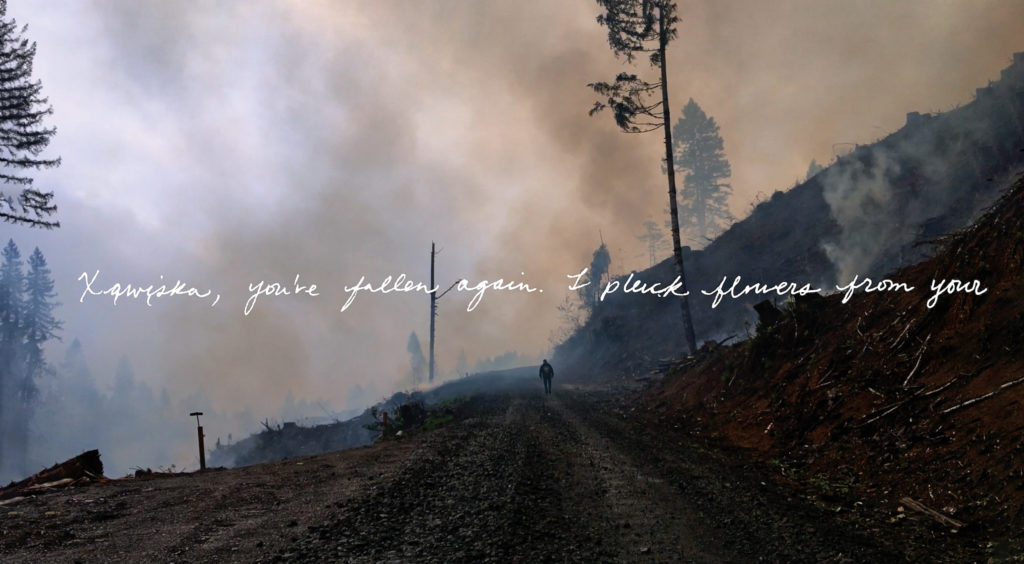 Sky Hopinka, Fainting Spells (still), 2018. HD video, stereo, colour, 10 minutes 45 seconds.
Sky Hopinka, Fainting Spells (still), 2018. HD video, stereo, colour, 10 minutes 45 seconds.
EH: In your film Anti-Objects, or Space Without Path or Boundary, there is a section of texts that says we are composed of matter and live in the midst of matter, that our objective should not be to renounce matter, but rather to search for a form of matter other than objects. What does that sentiment, that search for other forms of matter, mean to you?
SH: I was finding these different passages throughout a book by architect Kengo Kuma that resonated with me. They were about how to deal with landscape, objects and architecture—these embodiments of our culture or our cultural infrastructure—and they helped me think about other kinds of presence or other ways of being. There are the intangible parts of who we are in our identity. We have managed to survive 400 years of colonization. I think I had never really thought too much about what culture physically looks like—the paths, the roads, a village or a town. What would an Indigenous city look like? The passage in the film, in particular, brings up this idea of matter outside of the object and what an object is and how Kuma defines it. Objects are something that exist outside of the environment that they live in. So an object is very much an outside sort of thing. And an anti-object is then part of the system and part of the environments—it’s a more holistic way of being incorporated, even with the material aspects of Native culture or Native ways of being. For me it comes down to what we’re taught to value, or taught to devalue, about ourselves, and how empowering it can be to actually value those things, whether it is these different parts of our culture or cultures. We’re taught to be ashamed of them. What does it mean to not be ashamed of them, to actually recognize them for their value, worth and importance?
Pow wows, for example, are this thing that kind of go in and out of fashion; people criticize them because there’s so much money involved, or because it’s not any one tribal culture. Pow wows are very pan-Indigenous. But also, what does it mean for that to exist in the 1950s and 1960s? All the neon outfits and all these different materials go into making these things that are part of survival and not necessarily about the historical romanticized past, or about who people were or how these cultures lived, but rather the continuation of those lives. How do we look at our own continuation using these material objects and these different forms of matter that may exist in the ether or in the world that we’re touching? How can we then shift the narrative and just say, No, this is important, and this is part of our survival and a part of our history, and this is a place for it? Frybread is a good example of that too. It’s like a food made out of survival. It’s how we can still be here.

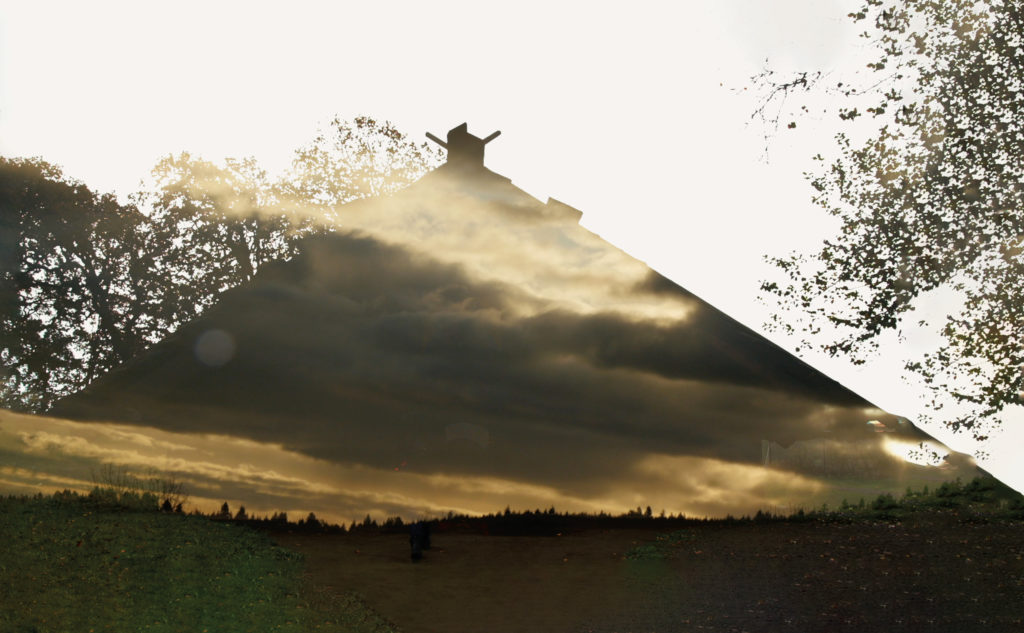 Sky Hopinka, Anti-Objects, or Space without Path or Boundary (still), 2017. HD video, stereo, colour, 13 minutes 5 seconds.
Sky Hopinka, Anti-Objects, or Space without Path or Boundary (still), 2017. HD video, stereo, colour, 13 minutes 5 seconds.
